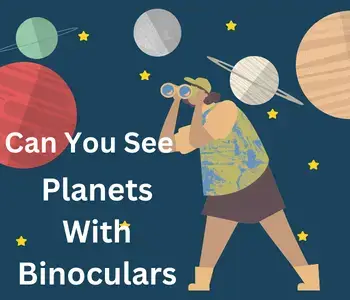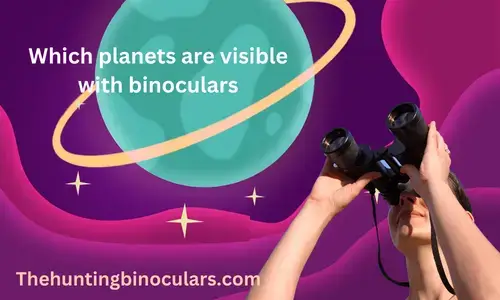
As we gaze up at the night sky, we often wonder about the mystery and beauty of the universe. We are curious about the planets orbiting around the sun and the possibility of observing them with our own eyes, or even with the help of binoculars. So, can you see planets with binoculars? Many people are curious about whether using binoculars can enhance their stargazing experience and help them see the planets more clearly.
Yes, it is possible to see planets with binoculars. Jupiter, Saturn, Mars, and Venus are some of the most commonly observed planets through binoculars. However, for better viewing, it is recommended to use a telescope as it provides a larger image and greater clarity.
In this article, I will explore the possibility of seeing planets with binoculars and what factors can affect the visibility of these celestial bodies.
Table of Contents
Can You See Planets with Binoculars Our Informative Guide
What are binoculars used for? Planets can be seen with binoculars, but the quality of the view will depend on a few factors, such as the size and quality of the binoculars, the atmospheric conditions, and the brightness of the planet.
The five bright planets in our solar system (Mercury, Venus, Mars, Jupiter, and Saturn) can all be seen with binoculars. Venus is usually the easiest planet to spot, as it is the brightest object in the sky after the Sun and the Moon.
When viewing planets with binoculars, it’s important to stabilize them using a tripod or another support to prevent shaking and ensure a steady image. It’s also helpful to observe from a dark location, away from city lights, to reduce light pollution and improve visibility.
Anatomy of binoculars
Binoculars consist of two identical telescopes, usually mounted side by side and aligned to point in the same direction. How binoculars are rated? They typically have the following components:
Objective lenses
These are the large lenses at the front of the binoculars, used to gather light and magnify the object being observed. They come in different sizes, with larger lenses gathering more light and providing a brighter image.
Prism
A prism is a specialized piece of glass that reflects light at a specific angle. In binoculars, prisms are used to orient the image to make it right-side-up and to reduce the amount of space needed for the optical path.
Eyepieces
These are the lenses located at the back of the binoculars, through which the viewer looks. They are responsible for magnifying the image that has been gathered by the objective lenses.
Focus knob
Used to adjust the focus of each eyepiece independently to account for individual differences in vision.
Diopter adjustment
This allows for fine-tuning of the focus for each eye, which can help correct differences in vision between the eyes.
Interpupillary distance adjustment
Allows the distance between the eyepieces to be adjusted to match the distance between the viewer’s eyes.
Lens coatings
Many binoculars have special coatings on their lenses to reduce glare and improve image clarity and contrast.
Body
The body of binoculars can be made of various materials such as metal, plastic, or rubber, and is designed to be comfortable to hold and easy to use.
Factors to consider for planetary observation with binoculars
How to choose binoculars for stargazing? Let’s read out.
Magnification: Planet-viewing binoculars
with magnifications between 8X and 15X are the most suitable for observing planets. Higher magnifications can cause the image to appear blurry and unstable due to atmospheric turbulence.
Aperture
Larger objective lenses allow more light to enter the binoculars, resulting in brighter and more vivid images of the planets.
Quality
The quality of the optics can greatly affect how well the binoculars perform for planetary observations. Look for brands that are known for producing high-quality optics.
Stability
It is important to use a stable platform when observing planets with binoculars. A tripod or mount can minimize shaky hands and provide a steadier image.
Comfort
It is essential to choose binoculars that are comfortable to use for extended periods. Consider the weight and grip of the binoculars to avoid fatigue and ensure a relaxed viewing experience.
Viewing conditions
Planetary observations are best made under clear and steady atmospheric conditions. Avoid observing planets when there is haze, clouds, or high humidity in the air.
Proper alignment
Ensure that your binoculars are properly aligned before observing the planets. Alignment can be checked by focusing on a distant object and making sure the left and right images are level and clear.
Which planets are visible with binoculars
All of the planets in our solar system can be viewed with binoculars at various times throughout the year. However, some planets are easier to spot than others due to their brightness and proximity to Earth.
The five binoculars to view planets throughout the year are:
- Mercury – can be seen near the horizon shortly after sunset or before sunrise.
- Venus – is visible as a bright “star” in the morning or evening sky, depending on its position in its orbit.
- Mars – Mars through binoculars appears as a reddish-orange orb in the evening sky when it is close to Earth.
- Jupiter – Jupiter with binoculars can be easily spotted as a bright, large disc in the night sky. It is one of the brightest objects in the sky after the Moon and Venus.
- Saturn –Saturn through binoculars has a distinctive ring system that can be seen with binoculars or a small telescope. It is visible in the evening sky during certain times of the year.

Binoculars to See the Moon
Yes, binoculars can be used to see the moon in more detail. However, it is always advisable to use a tripod or stabilize it on a flat surface to avoid any image shake or distortion. Additionally, it is recommended to use binoculars with a magnification of at least 7X or 8X to get the best view of the moon’s surface features. Also, you should know what are the strongest binoculars.
Tips for observing planets with binoculars
Choose a clear night
For the best viewing conditions, choose a clear night when there is little to no cloud cover. Light pollution can also affect the visibility of the planets, so try to observe from a location away from city lights.
Use high-quality binoculars
High-quality binoculars with larger objective lenses will provide better clarity and brightness of the planet. A magnification of 10x or higher is ideal for planet observation.
Stabilize your binoculars
Any sudden movement can lead to blurring or a shaky image, so it’s important to stabilize your binoculars. Use a tripod, or rest your elbows on a stable surface like a wall, fence, or car roof.
Focus on your binoculars
Adjust the focus of your binoculars until the planet appears sharp and clear. You may need to adjust the focus as the planet moves across the sky.
Observe during the right time
Planets are visible at different times of the year and different times of the day. Research online or consult an astronomy app to determine the best time to observe the particular planet you are interested in.
Learn about the planet’s features
Make note of any notable features on the planet, such as craters, moons, or rings. This will enhance your observation experience and help you learn more about the planet.
Be patient
Depending on the position of the planet, it may take a while to locate it in your binoculars. Be patient and keep searching until you find it.
FAQ’s
Can you use binoculars to look at the planets?
You can use binoculars to observe some planets, such as Jupiter and Saturn. You may be able to see their larger moons and some of their features but don’t expect to see much detail. For more detailed observations of the planets, you will need a telescope.
How strong binoculars do I need to see planets?
Magnifications of at least 10X are required to see Jupiter and its moons, Saturn and its rings, or Mars and its major surface features. However, for optimal viewing, a magnification of 15X to 20X or higher is recommended. High-quality binoculars with an aperture of at least 50mm are recommended for viewing planets.
What kind of binoculars do I need to see planets?
You will need powerful binoculars with a large objective lens diameter, high magnification, and good optical quality to see planets in detail. Binoculars with at least 10X magnification and a 50mm or larger objective lens diameter are ideal for this purpose.
Can I see galaxies with binoculars
Yes, you can see some galaxies with binoculars, but they will appear as faint and fuzzy patches of light. However, for better viewing of galaxies, it is recommended to use a telescope with a larger aperture that can collect more light and provide greater magnification.
Conclusion
Can you see planets with binoculars? With the help of a clear night sky, a sturdy tripod, and the right magnification, it is possible to see gas giants like Jupiter and Saturn, as well as the closer and smaller planets like Venus and Mars. While using binoculars will not provide the same level of detail as a telescope, they offer a much more affordable and portable option for stargazers of all ages and experience levels.
For further queries, you can mention your questions in the comment box. Thank you!
